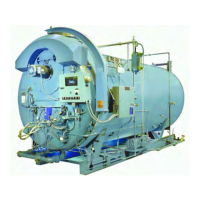Chapter 6 — Adjustment Procedures
Part No. 750-184 6-15
Pressure Correction
The flow rate outlined in Section P is based on a “base” pressure,
which is usually atmospheric or 14.7 psia.
Meters generally measure gas in cubic feet at “line” or supply
pressure. To convert the volume obtained from a meter reading into
cubic feet at base pressure, it is necessary to multiply the meter
index reading by the correction factor obtained from Table 6-4.
Conversely:
To determine what the meter index reading should be in order to
provide the volume of gas required for input, divide the desired flow
rate by the proper pressure correction factor. This answer indicates
the number of cubic feet at line pressure which must pass through
the meter to deliver the equivalent number of cubic feet at base
pressure.
As an example:
Assume that a 200 horsepower boiler is installed at 2,000 feet
above sea level; is equipped with a standard gas train and a high
turndown burner; and that 1,000 Btu natural gas is available with
an incoming gas pressure of 3 psig. The pressure and flow
requirements can be determined as follows:
Table 6-4 Pressure Correction
Factors
REGULATOR INLET
PRESSURE (PSIG)
PRESSURE
FACTOR
11.05
21.11
31.18
41.25
51.32
61.39
71.45
81.53
91.59
10 1.66
11 1.72
12 1.81
13 1.86
14 1.93
15 2.00
Table 6-5 Altitude Correction Factors
ALTITUDE
FEET ABOVE SEA LEVEL
CORRECTION FACTOR
1000 1.04
2000 1.07
2500 1.09
3000 1.11
4000 1.16
5000 1.21
6000 1.25
7000 1.30
8000 1.35
9000 1.40
Table 6-6 Max. gas
consumption (natural gas)
CB-LE
HP FT
3
/HR
125 5103
150 6124
200 8165
CB OHIO SPECIAL
HP FT
3
/HR
125S 5230
150S 6280
175S 7350
200S 8370
225S 9415

